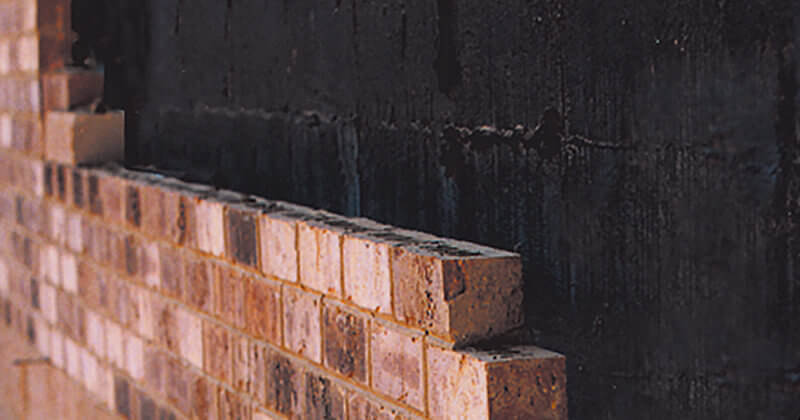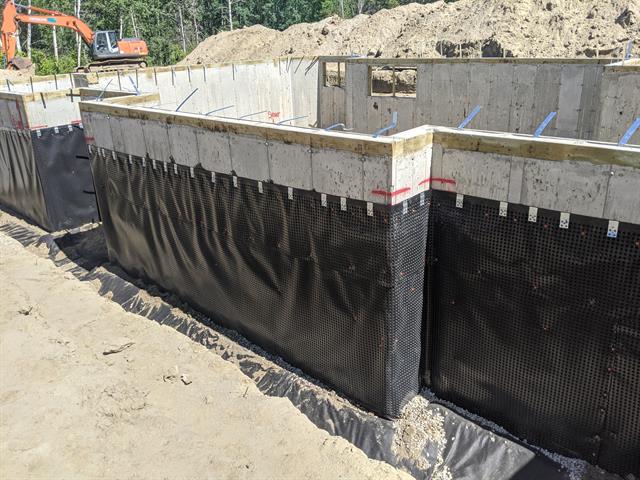Top 5 causes of penetrating damp and how mould removal newcastle can help
Top 5 causes of penetrating damp and how mould removal newcastle can help
Blog Article
Exploring the Numerous Methods and Solutions for Effective Damp Proofing
Dampness in structures poses significant obstacles to both structural stability and interior air quality. Numerous methods and services have emerged to fight this pervasive issue. From standard damp-proof membrane layers to ingenious chemical treatments, each technique provides distinct benefits. Recognizing these choices is essential for reliable dampness control. Nevertheless, selecting the right remedy depends upon certain structure conditions and needs, triggering additional expedition into the most effective wet proofing strategies available.
Recognizing the Reasons of Dampness
Wetness can occur from different sources, understanding these reasons is vital for reliable remediation. Generally, wetness originates from 3 primary resources: rising moist, permeating moist, and condensation. Climbing moist takes place when groundwater takes a trip up-wards through porous materials, such as brick or stone, frequently as a result of a lack of an effective barrier (mould removal newcastle). Passing through moist is typically brought on by exterior factors, including roofing system leaks, faulty gutters, or harmed walls, allowing water to infiltrate a property. Condensation, on the various other hand, arises from excess moisture in the air, commonly aggravated by inadequate air flow and temperature level distinctions, resulting in water droplets developing on surfaces. Recognizing these underlying problems is important, as each type of moisture needs a tailored strategy for remediation. Correct evaluation assists in determining the most efficient remedies, inevitably securing the structural integrity of a structure and boosting interior air top quality
Standard Damp-Proof Membranes

Chemical Damp-Proofing Solutions
Chemical damp-proofing remedies supply an ingenious approach to avoiding dampness breach in buildings. These approaches commonly entail the application of fluid chemicals that penetrate masonry and develop an obstacle against increasing moist. Frequently made use of chemicals include silanes, siloxanes, and various other water-repellent representatives that react with surface area materials to produce a hydrophobic layer.The application procedure usually calls for drilling openings into the wall surfaces, infusing the chemical service, and enabling it to cure. This technique is especially advantageous for older frameworks where traditional damp-proof membrane layers may be unwise. Chemical damp-proofing can be less turbulent and much more cost-effective than considerable restoration projects.While reliable, these services depend on appropriate application and environmental problems for peak efficiency. damp removal newcastle. Routine upkeep and surveillance are important to assure the long life of the damp-proofing therapy. Generally, chemical damp-proofing stands for a functional option for protecting buildings against moisture-related damages
Dental Caries Wall Surface Construction Strategies
Tooth cavity wall building methods use various advantages, especially in wetness control and energy effectiveness. By including an air gap between two layers of masonry, these walls efficiently minimize water access while enhancing insulation. This mix not just safeguards structures from wetness however additionally adds to reduced power consumption.
Advantages of Dental Caries Walls
When taking into consideration reliable damp proofing techniques, the advantages of tooth cavity walls stick out prominently. Dental caries walls include 2 different layers, producing an air gap that successfully lowers moisture penetration. This style minimizes the danger of dampness, as the external wall serves as a barrier against rain and water access. Furthermore, cavity wall surfaces boost thermal insulation, which adds to energy effectiveness by minimizing warm loss. They also offer audio insulation, helping to produce a quieter indoor atmosphere. The air void permits for air flow, which assists in dampness control and lowers the chance of mold and mildew development. These benefits not just enhance the total comfort of a structure however also add to its long life and structural integrity.
Moisture Control Strategies
Efficient wetness control strategies are important in dental caries wall surface building to assure long-lasting protection against wetness. One key method entails the incorporation of weep openings, which facilitate water drain from the cavity, avoiding buildup. Additionally, using breathable membranes can help manage moisture degrees while permitting caught vapor to get away. Correct positioning of insulation is additionally vital, as it must not obstruct drainage paths. Ensuring that the outer leaves of the tooth cavity wall surface are created with water-resistant products improves general resilience. Routine upkeep checks are essential to determine any type of clogs or damage early, safeguarding the framework's honesty. Inevitably, a mix of these methods forms a durable defense against dampness breach in dental caries walls.
Insulation and Power Effectiveness
Insulation plays a vital function in improving energy efficiency within dental caries wall surface building. By integrating shielding materials, these wall surfaces develop a thermal barrier that minimizes warm loss and minimizes energy usage. Effective insulation not just assists maintain a steady interior temperature yet additionally alleviates the danger of wetness, as it protects against condensation within the wall surface tooth cavity. Various techniques, such as using stiff foam boards or mineral wool, can be employed to achieve ideal insulation performance. In addition, appropriate installment is crucial to assure that gaps and voids are minimized, which can or else endanger power efficiency. Ultimately, a well-insulated dental caries wall contributes greatly to total sustainability and reduces heating and cooling prices for home owners.
External Damp Proofing Techniques
Exterior damp proofing techniques are crucial for securing frameworks from wetness infiltration. 2 efficient strategies include the application of water resistant membranes and the setup of French drains. These solutions assist minimize water build-up and protect the honesty of buildings.
Waterproof Membrane Application
While different approaches exist for preventing wetness access, the application of water resistant membrane layers remains a very reliable outside moist proofing method. These membrane layers are typically made from products such as polyethylene, rubber, or customized bitumen, giving a robust obstacle versus water infiltration. The setup procedure entails using the membrane layer to the outside surface areas of wall surfaces or structures, ensuring full coverage to stop leaks. Correct bond and securing at joints are vital to optimizing performance. Waterproof membrane layers can be used in various kinds, including fluid finishings and sheet membranes, allowing for adaptability based upon the certain needs of the framework. This technique not just secures structures from moisture yet likewise boosts their long life and architectural stability.
French Drainpipe Setup
One reliable technique for handling groundwater and avoiding dampness build-up around a structure's foundation is the installment of a French drainpipe. This drainage system is composed of a trench full of crushed rock and a perforated pipe that redirects surface water away from the structure. Appropriate setup needs cautious planning, guaranteeing that the drainpipe slopes far from the framework to promote optimal water flow. Furthermore, the place of the drain is crucial; it should be positioned in areas prone to merging or excess moisture. Routine maintenance, consisting of cleaning debris from the gravel and making sure the pipeline remains unblocked, is important for lasting effectiveness. Eventually, a well-installed French drainpipe can considerably reduce the threat of water-related issues in structures and cellars.
Inside Waterproofing Techniques
Inside waterproofing strategies are important for safeguarding a building's inside from moisture infiltration and possible water damage. These methods generally involve the application of specialized products and techniques created to produce a dampness barrier within the framework. One usual approach is using waterproof coverings or sealers on wall surfaces and floors, which protect against moisture from passing through surfaces.Additionally, installing interior drainage systems, such as sump pumps, can effectively take care of water buildup in basements and crawl spaces. An additional technique entails using vapor obstacles, which are installed to inhibit moisture activity from the ground into living spaces.Moreover, attending to any cracks or voids in walls or structures with suitable sealers ensures a comprehensive defense against water invasion. By carrying out these interior waterproofing approaches, building owners can considerably decrease the risk of mold growth, architectural damages, and other moisture-related concerns. Correct implementation of these strategies is necessary for lasting security and structure integrity.
Routine Maintenance and Inspection Practices
Regular upkeep and inspection techniques are essential for guaranteeing the long-term efficiency of damp proofing options in any kind of building. Routine checks allow homeowner to identify early indications of wetness intrusion, such as peeling paint, mold development, and musty odors. These indicators can signify underlying problems that require instant attention.Inspections must be carried out at the very least every year, concentrating on at risk locations like cellars, crawl rooms, and outside wall surfaces. During these analyses, residential or commercial property owners need to take a look at sealants, drainage systems, and air flow to confirm they operate correctly.Additionally, preserving seamless gutters and downspouts is crucial, as blocked systems can bring about water build-up near the foundation. Executing a normal upkeep schedule, in addition to prompt repairs, can considerably expand the life-span of moist proofing procedures and protect the structural honesty of the building. Proactive procedures eventually add to the general health and wellness and safety of the living atmosphere.
Frequently Asked Concerns
How Long Does Damp Proofing Usually Last?
The duration of wet proofing effectiveness differs, normally lasting in between 20 to 50 years. Factors such as application high quality, ecological problems, and upkeep practices considerably affect the long life of the damp proofing therapy.

Can I Damp Evidence My Home Myself?
The private considered the expediency of do it yourself damp proofing. With appropriate study and the appropriate materials, it is possible. They additionally acknowledged the relevance of specialist assistance to assure lasting efficiency and avoid future problems.
What Are the Indicators of Inadequate Damp Proofing?
Indicators of inefficient damp proofing consist of relentless mildewy smells, noticeable mold and mildew development, peeling off paint, moist patches on wall surfaces, and wood decay - mould removal newcastle. Homeowners need to deal with these concerns promptly to avoid additional damages and health problems
Does Damp Proofing Affect Indoor Air Quality?

Just How Much Does Professional Damp Proofing Price?
Professional get more info wet proofing expenses vary considerably, normally varying from $1,000 to $5,000 relying on the property's size, the degree of the wet issue, and chosen approaches. Each scenario calls for a customized evaluation for accurate pricing. Generally, wetness stems from three primary resources: rising damp, permeating moist, and condensation. When taking into consideration reliable moist proofing techniques, the benefits of dental caries walls stand out plainly. Exterior moist proofing approaches are vital for protecting frameworks from wetness seepage. While different methods exist for avoiding wetness ingress, the application of waterproof membranes remains a very efficient external damp proofing strategy. Indications of ineffective moist proofing consist of relentless stuffy odors, visible mold development, peeling off paint, moist spots on wall surfaces, and wood degeneration.
Report this page